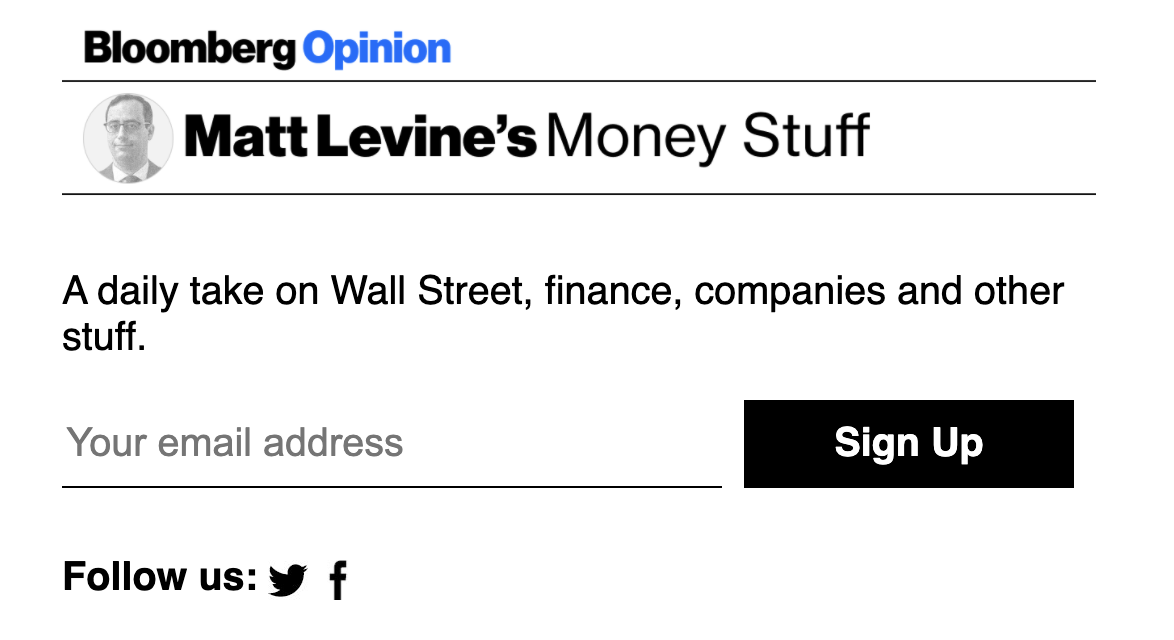They’re All Friends in the Index
Matt Levine
Bloomberg, July 20, 2020
Matt Levine is a Bloomberg Opinion columnist covering finance. He was an editor of Dealbreaker, an investment banker at Goldman Sachs, a mergers and acquisitions lawyer at Wachtell, Lipton, Rosen & Katz, and a clerk for the U.S. Court of Appeals for the 3rd Circuit.
You know the theory. Common ownership of multiple companies in the same industry by big diversified institutional investors should cause the companies to compete less: If all their profits are going to the same place (the investors who own all of them), then no one should care about which particular company earns the profits; all they should care about is that the total profits are as high as possible. So nobody should compete on price; they should raise prices, not care about market share, and make total profits as high as possible to please their common owners.
It’s not really a theory about index funds, but I sometimes jokingly call it “should index funds be illegal” because the rise of institutional common owners is connected with the rise of big index funds. The archetypal common owners are BlackRock and Vanguard and State Street, the “Big Three” index-fund providers, who by necessity own lots of competitors in lots of industries.
Here is one testable implication of this theory. Imagine an industry with three big companies, Company A, Company B and Company C. Company A and Company B are in the S&P 500 index; Company C is just barely not. It’s the 501st company on the list, say. Company A and Company B will be jointly owned by a lot of index funds—enormous amounts of money are indexed to the S&P 500—and also by other large-cap funds that compare themselves to the S&P 500. Company C will have much less overlap, though; all of the S&P 500-focused investors will ignore it. Company C will (taking the theory quite literally) want to compete with Company A and Company B by lowering prices, etc., giving up profits to gain market share. And so Company A and Company B will have to compete with Company C, lowering their prices to defend their market share.
But then Company C gets bumped up the list, say to number 499, and is added to the S&P 500. The big index funds—which already own lots of Company A and Company B—will go buy Company C stock. Company C will now share much more of its ownership with Company A and Company B. Again taking the theory very literally, Company C will no longer want to compete as vigorously: It now has the same owners as Company A and Company B, so why should it fight with them over market share?
So the implication is that, when Company C is added to the S&P 500, the stocks of Company A and Company B should go up, since they now face less competition.
We test if an increase in common ownership changes future expected profits with an event study method. We collect instances of a stock entering the S&P 500 index and identify its product market competitors. We measure the change in institutional and common ownership (with product market rivals) and find that entering stocks experience a significant increase in both. We measure the stock returns of the entrant’s product market rivals upon the entry news. We find that increases in common ownership (driven by the whole vector of ownership similarity) cause increases in stock returns, consistent with a hypothesis that common ownership raises profits.
That is the abstract of “Testing the Theory of Common Stock Ownership,” by Lysle Boller of Duke and Fiona Scott Morton of Yale. From the paper:
Consistent with previous literature, we find that the stock prices of index entrants increase at the time of entry likely due to both demand and common ownership effects, and we provide evidence that the size of this increase is linked to the size of the change in institutional ownership that results from index entry. Most strikingly, we find that competitors who are themselves index incumbents incur higher abnormal returns upon the entry of their rivals when compared with non-incumbent competitors. This finding is supported by a null result for two control groups. Entrants that do not experience an increase in institutional ownership do not generate similar spillover effects to their rivals and competitors that are not index incumbents do not incur higher abnormal returns.
Being added to the S&P 500 is good for a company’s stock, but it’s also good for its competitors’ stock, as long as they are also in the S&P 500. Because they are all friends, there in the S&P 500; they all have the same owners and are working toward the same goals.
_____
If you’d like to get Money Stuff in handy email form, right in your inbox, please subscribe at this link. Or you can subscribe to Money Stuff and other great Bloomberg newsletters here. Thanks!


